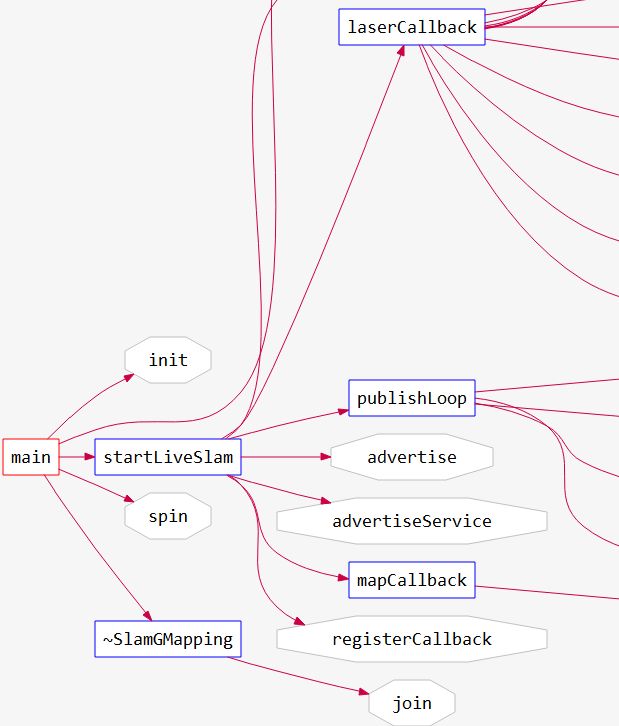gmapping 分析
【转载】这一篇先讲我对gmapping源码的理解(难免有错,欢迎指正,相互学习)。
原博客:https://blog.csdn.net/roadseek_zw/article/details/53316177,博客主页:https://blog.csdn.net/roadseek_zw
参考论文:
Improved Techniques for Grid Mapping with Rao-Blackwellized Particle Filters
参考博客:
http://blog.csdn.net/heyijia0327/article/details/40899819 pf原理讲解
http://blog.csdn.net/u010545732/article/details/17462941 pf代码实现
http://www.cnblogs.com/yhlx125/p/5634128.html gmapping分析
http://wenku.baidu.com/view/3a67461550e2524de4187e4d.html?from=search gmapping 分析
其他参考 :
http://ishare.iask.sina.com.cn/f/24615049.html
从ros官网上下载 slam_gmapping 包以及在openslam ( http://openslam.org/ )上下载openslam_gmapping包。
为了方便的阅读源码,这里强力推荐一款源码阅读软件 understand (聪明的你一定找的到资源),可以方便实现各种跳转与生成图、表、树,流程等。
废话不多说了,开始看源码,对于我这种c++都没有过关的菜鸟,看着大几千行的c++的代码,简直是身体和精神上的蹂躏。
先说说 slam_gmapping 包与openslam_gmapping包
进入slam_gmapping 的main.cpp文件的关系,slam_gmapping 是openslam_gampping在ros下的二次封装,你可以直接用这个包,而真正的核心代码实现都在openslam_gampping里面。
进入代码
先用understand 看看代码的调用关系。 (调用太复杂了,图太大,我就截取了一小部分) 
转到
gn.startLiveSlam();
{
entropy_publisher_ = private_nh_.advertise("entropy", 1, true);
sst_ = node_.advertise("map", 1, true);
sstm_ = node_.advertise("map_metadata", 1, true);
ss_ = node_.advertiseService("dynamic_map", &SlamGMapping::mapCallback, this);
scan_filter_sub_ = new message_filters::Subscriber(node_, "scan", 5);
scan_filter_ = new tf::MessageFilter(*scan_filter_sub_, tf_, odom_frame_, 5);
scan_filter_->registerCallback(boost::bind(&SlamGMapping::laserCallback, this, _1));
transform_thread_ = new boost::thread(boost::bind(&SlamGMapping::publishLoop, this, transform_publish_period_));
} 也没写啥,主要就是一些消息的回调以及发布一些服务,重点在
void SlamGMapping::laserCallback(const sensor_msgs::LaserScan::ConstPtr& scan)
{
laser_count_++;
/*每隔throttle_scans_ (默认值 1)帧数据计算一次,限流作用*/
if ((laser_count_ % throttle_scans_) != 0)
return;
static ros::Time last_map_update(0,0);
/* We can't initialize the mapper until we've got the first scan */
if(!got_first_scan_)
{
/*一些重要参数的初始化,将slam里的参数传递到 openslam 里 ,设定坐标系,坐标原点,以及采样函数随机种子的初始化,等等
里面还调用了 GridSlamProcessor::init ,这个初始化了粒子数,子地图大小 */
if(!initMapper(*scan))
return;
got_first_scan_ = true;
}
GMapping::OrientedPoint odom_pose;
/**
pay attention: addScan这个函数*要转到pf的核心代码了 ,将调用processScan
*/
if(addScan(*scan, odom_pose))
{
ROS_DEBUG("scan processed");
GMapping::OrientedPoint mpose = gsp_->getParticles()[gsp_->getBestParticleIndex()].pose;
ROS_DEBUG("new best pose: %.3f %.3f %.3f", mpose.x, mpose.y, mpose.theta);
ROS_DEBUG("odom pose: %.3f %.3f %.3f", odom_pose.x, odom_pose.y, odom_pose.theta);
ROS_DEBUG("correction: %.3f %.3f %.3f", mpose.x - odom_pose.x, mpose.y - odom_pose.y, mpose.theta - odom_pose.theta);
tf::Transform laser_to_map = tf::Transform(tf::createQuaternionFromRPY(0, 0, mpose.theta), tf::Vector3(mpose.x, mpose.y, 0.0)).inverse();
tf::Transform odom_to_laser = tf::Transform(tf::createQuaternionFromRPY(0, 0, odom_pose.theta), tf::Vector3(odom_pose.x, odom_pose.y, 0.0));
map_to_odom_mutex_.lock();
map_to_odom_ = (odom_to_laser * laser_to_map).inverse();
map_to_odom_mutex_.unlock();
if(!got_map_ || (scan->header.stamp - last_map_update) > map_update_interval_)
{
updateMap(*scan); //更新地图
last_map_update = scan->header.stamp;
ROS_DEBUG("Updated the map");
}
} else
ROS_DEBUG("cannot process scan");
}在 processScan 函数里依次执行了
运动模型
更新t时刻的粒子群,(模型中加入了高斯噪声)
你要问我是为啥是这样的公式,请自行参考《Probabilistic Robot 》一书的P107页 ,里程计运动模型
relPose 当前时刻的位姿(x,y,theta) ,m_odoPose 上一时刻的位姿
OrientedPoint
MotionModel::drawFromMotion(const OrientedPoint& p, const OrientedPoint& pnew, const OrientedPoint& pold) const{
double sxy=0.3*srr; //目测是两轮轴间耦合方差,有点诡异???
OrientedPoint delta=absoluteDifference(pnew, pold);
OrientedPoint noisypoint(delta); //噪声估计
noisypoint.x+=sampleGaussian(srr*fabs(delta.x)+str*fabs(delta.theta)+sxy*fabs(delta.y));
noisypoint.y+=sampleGaussian(srr*fabs(delta.y)+str*fabs(delta.theta)+sxy*fabs(delta.x));
noisypoint.theta+=sampleGaussian(stt*fabs(delta.theta)+srt*sqrt(delta.x*delta.x+delta.y*delta.y));
noisypoint.theta=fmod(noisypoint.theta, 2*M_PI);
if (noisypoint.theta>M_PI)
noisypoint.theta-=2*M_PI;
return absoluteSum(p,noisypoint); //叠加噪声
}计算t-1 —> t 时刻的 位移增量,以及角位移增量
OrientedPoint move=relPose-m_odoPose;
move.theta=atan2(sin(move.theta), cos(move.theta));
m_linearDistance+=sqrt(move*move);
m_angularDistance+=fabs(move.theta);
if (! m_count ||m_linearDistance>=m_linearThresholdDistance
|| m_angularDistance>=m_angularThresholdDistance
|| (period_ >= 0.0 && (reading.getTime() - last_update_time_) > period_))
{
//...
}if 里面有几个重要的函数,如下
扫描匹配
通过匹配选取最优的粒子,如果匹配失败,则返回一个默认的似然估计
原理就参考 《Probabilistic Robot》 一书的P143 页 , likelihood_field_range_finder_mode
inline void GridSlamProcessor::scanMatch(const double* plainReading){
/* sample a new pose from each scan in the reference */
double sumScore=0;
for (ParticleVector::iterator it=m_particles.begin(); it!=m_particles.end(); it++){
OrientedPoint corrected;
double score, l, s;
/* 计算最优的粒子
optimize 调用了 score 这个函数 (计算粒子得分)
在score 函数里,首先计算障碍物的坐标phit,然后将phit转换成网格坐标iPhit
计算光束上与障碍物相邻的非障碍物网格坐标pfree,pfrree由phit沿激光束方向移动一个网格的距离得到,将pfree转换成网格坐标ipfree(增量,并不是实际值)
在iphit 及其附近8个(m_kernelSize:default=1)栅格(pr,对应自由栅格为pf)搜索最优可能是障碍物的栅格。
最优准则: pr 大于某一阈值,pf小于该阈值,且pr栅格的phit的平均坐标与phit的距离bestMu最小。
得分计算: s +=exp(-1.0/m_gaussianSigma*bestMu*besMu) 参考NDT算法,距离越大,分数越小,分数的较大值集中在距离最小值处,符合正态分布模型
至此 score 函数结束并返回粒子(currentPose)得分,然后回到optimize函数
optimize 干的事就是 currentPose 的位姿进行微调,前、后、左、右、左转、右转 共6次,然后选取得分最高的位姿,返回最终的得分
*/
score=m_matcher.optimize(corrected, it->map, it->pose, plainReading);
if (score>m_minimumScore){ //判断得分是否符合要求
it->pose=corrected;
} else {
if (m_infoStream){
m_infoStream << "Scan Matching Failed, using odometry. Likelihood=" << l <map, it->pose, plainReading);
sumScore+=score;
it->weight+=l;
it->weightSum+=l;
/* 计算可活动区域
//set up the selective copy of the active area
//by detaching the areas that will be updated
computeActiveArea 用于计算每个粒子相应的位姿所扫描到的区域
计算过程首先考虑了每个粒子的扫描范围会不会超过子地图的大小,如果会,则resize地图的大小
然后定义了一个activeArea 用于设置可活动区域,调用了gridLine() 函数,这个函数如何实现的,
请参考百度文库那篇介绍。
*/
m_matcher.invalidateActiveArea();
m_matcher.computeActiveArea(it->map, it->pose, plainReading);
}
if (m_infoStream)
m_infoStream << "Average Scan Matching Score=" << sumScore/m_particles.size() << std::endl;
} 权重更新
重采样前更新过一次,重采样后又更新过一次,更新原理,参见论文(表示不是太懂)
void GridSlamProcessor::updateTreeWeights(bool weightsAlreadyNormalized){
if (!weightsAlreadyNormalized) {
normalize(); //Neff 计算 (论文中公式20)
}
resetTree(); //初始化粒子的树节点 权重,访问次数 ,父节点
propagateWeights(); //为了迭代计算,计算上一次的该粒子的权重 (论文中公式19)
}重采样
粒子集对目标分布的近似越差,则权重的方差越大,可用Neff来度量,具体原理参见论文,以及白巧克力亦唯心的那篇博客
代码太长了就不粘贴了
重采样里还调用了registerScan ,这个函数和computeActive 函数有点像,不同的是,registerScan用于注册每个单元格
的状态,自由、障碍,调用update()以及entroy()函数更新,最后是障碍物的概率 p=n/visits ,
障碍物的坐标用平均值来算完了后,又有一次权重计算。
至此,processScan 结束,回到laserCallback,还有最优一步updateMap
resample(plainReading, adaptParticles, reading_copy);地图更新
先得到最优的粒子(用权重和 weightSum判断 ),得到机器人最优轨迹
地图膨胀更新
void
SlamGMapping::updateMap(const sensor_msgs::LaserScan& scan)
{
ROS_DEBUG("Update map");
boost::mutex::scoped_lock map_lock (map_mutex_);
GMapping::ScanMatcher matcher;
matcher.setLaserParameters(scan.ranges.size(), &(laser_angles_[0]),
gsp_laser_->getPose());
matcher.setlaserMaxRange(maxRange_);
matcher.setusableRange(maxUrange_);
matcher.setgenerateMap(true);
/* 取最优粒子,根据权重和weightSum 判断(最大) */
GMapping::GridSlamProcessor::Particle best =
gsp_->getParticles()[gsp_->getBestParticleIndex()];
std_msgs::Float64 entropy;
entropy.data = computePoseEntropy();
if(entropy.data > 0.0)
entropy_publisher_.publish(entropy);
if(!got_map_) {
map_.map.info.resolution = delta_;
map_.map.info.origin.position.x = 0.0;
map_.map.info.origin.position.y = 0.0;
map_.map.info.origin.position.z = 0.0;
map_.map.info.origin.orientation.x = 0.0;
map_.map.info.origin.orientation.y = 0.0;
map_.map.info.origin.orientation.z = 0.0;
map_.map.info.origin.orientation.w = 1.0;
}
GMapping::Point center;
center.x=(xmin_ + xmax_) / 2.0;
center.y=(ymin_ + ymax_) / 2.0;
GMapping::ScanMatcherMap smap(center, xmin_, ymin_, xmax_, ymax_,
delta_);
ROS_DEBUG("Trajectory tree:");
/*得到机器人最优轨迹 */
for(GMapping::GridSlamProcessor::TNode* n = best.node;
n;
n = n->parent)
{
ROS_DEBUG(" %.3f %.3f %.3f",
n->pose.x,
n->pose.y,
n->pose.theta);
if(!n->reading)
{
ROS_DEBUG("Reading is NULL");
continue;
}
/*重新计算栅格单元的概率*/
matcher.invalidateActiveArea();
matcher.computeActiveArea(smap, n->pose, &((*n->reading)[0]));
matcher.registerScan(smap, n->pose, &((*n->reading)[0]));
}
/* the map may have expanded, so resize ros message as well */
if(map_.map.info.width != (unsigned int) smap.getMapSizeX() || map_.map.info.height != (unsigned int) smap.getMapSizeY()) {
/* NOTE: The results of ScanMatcherMap::getSize() are different from the parameters given to the constructor
so we must obtain the bounding box in a different way */
GMapping::Point wmin = smap.map2world(GMapping::IntPoint(0, 0));
GMapping::Point wmax = smap.map2world(GMapping::IntPoint(smap.getMapSizeX(), smap.getMapSizeY()));
xmin_ = wmin.x; ymin_ = wmin.y;
xmax_ = wmax.x; ymax_ = wmax.y;
ROS_DEBUG("map size is now %dx%d pixels (%f,%f)-(%f, %f)", smap.getMapSizeX(), smap.getMapSizeY(),
xmin_, ymin_, xmax_, ymax_);
map_.map.info.width = smap.getMapSizeX();
map_.map.info.height = smap.getMapSizeY();
map_.map.info.origin.position.x = xmin_;
map_.map.info.origin.position.y = ymin_;
map_.map.data.resize(map_.map.info.width * map_.map.info.height); //地图需要膨胀
ROS_DEBUG("map origin: (%f, %f)", map_.map.info.origin.position.x, map_.map.info.origin.position.y);
}
/*确定地图的未知区域、自由区域、障碍 */
for(int x=0; x < smap.getMapSizeX(); x++)
{
for(int y=0; y < smap.getMapSizeY(); y++)
{
/// @todo Sort out the unknown vs. free vs. obstacle thresholding
GMapping::IntPoint p(x, y);
double occ=smap.cell(p);
assert(occ <= 1.0);
if(occ < 0)
map_.map.data[MAP_IDX(map_.map.info.width, x, y)] = -1;
else if(occ > occ_thresh_)
{
//map_.map.data[MAP_IDX(map_.map.info.width, x, y)] = (int)round(occ*100.0);
map_.map.data[MAP_IDX(map_.map.info.width, x, y)] = 100;
}
else
map_.map.data[MAP_IDX(map_.map.info.width, x, y)] = 0;
}
}
got_map_ = true;
//make sure to set the header information on the map
map_.map.header.stamp = ros::Time::now();
map_.map.header.frame_id = tf_.resolve( map_frame_ );
sst_.publish(map_.map);
sstm_.publish(map_.map.info);
}至此,整个gmapping 的主线已经挑出来了,当然里面还有很多初始化我没讲,而且有很多细节我也还没有弄清楚,
还有待进一步的研究(比如地图是如何膨胀的,扫描匹配得分计算的具体实施过程)。